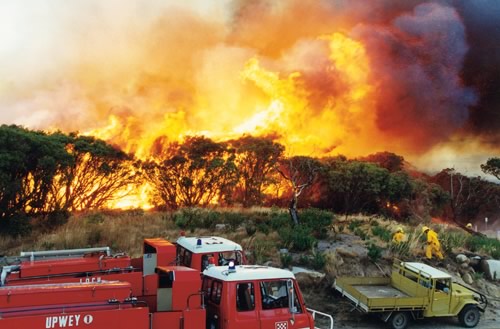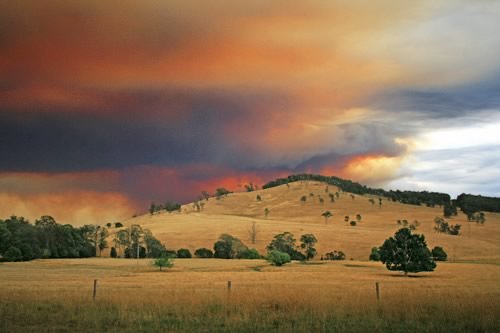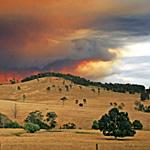Bushfire weather
22 March 2013
Weather is an important component for bushfire spread (in conjunction with fuels and topography). Droughts and dry spells create a high fire risk, particularly if the dry spell follows a period of good rain that has encouraged lush growth in the forests and grasslands.
Low relative humidity, high winds and lack of rain all contribute to increased fire danger. Sunshine and high temperatures rapidly dry timber and grass which burn very quickly. Hot air can lower the moisture content of forests and grasslands to around five per cent and in extreme cases to two to three per cent, greatly increasing the speed of the fire.

Image: Bushfire at Mount Martha, Victoria, in 1997.
Humidity
Relative humidity is commonly used to measure atmospheric moisture. It is defined as the ratio of the amount of water vapour measured to what the air could hold at saturation point. Very low relative humidity, say less than 20%, causes fuels to dry out and become more flammable.
Wind
Air movement provides the oxygen the fire needs to keep burning. Higher winds mean more oxygen and more intense flames. Doubling the wind speed quadruples the rate of spread of the fire, although this ratio starts to break down for winds over 50 km/h.
Winds can carry burning embers downwind, starting new fires (or 'spotfires', through a process known as 'spotting'). For winds above 80 km/h, the rate of spread in grasslands reduces because the head fire breaks up into narrow tongues, many of which become self-extinguishing.
Rainfall
Dry grass, parched native shrubs and dead leaves and twigs are a fire's basic fuel. During droughts and in very hot, windy weather, even heavy fuels like large logs and the green leaves and smaller branches of large trees can become dry and flammable.
Heavy rainfall might quench a fire, but it can make it difficult for firefighters to access burnt areas. Where fires have been intense, or occur over steep terrain, heavy rain might cause severe erosion and affect water quality when rivers carry ash and sediment along.
Lightning
Thunderstorms can form in an unstable atmosphere, producing lightning. In some parts of Australia lightning is the main source of bushfire ignition. The winds during thunderstorms can make it hard to predict the behaviour and movement of a bushfire.

Image: Pyrocumulus cloud and bushfire smoke.
Read more

Subscribe to this blog to receive an email alert when new articles are published.


Comment. Tell us what you think of this article.
Share. Tell others.